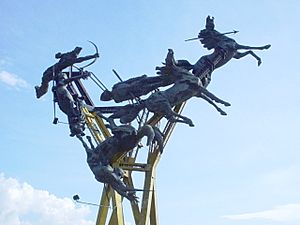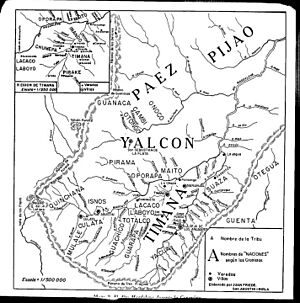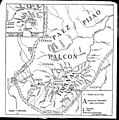Gaitana facts for kids
Gaitana, also called Guaitipan, La Gaitana, or Cacica Gaitana, was a brave leader from the 1500s. She was a cacica, which means a female chief, of the Yalcon people. Her home was in the Timaná region of Huila, Colombia.
Around 1539–1540, Gaitana led her people in the Upper Magdalena River Valley. They fought against the Spanish who were trying to take over their lands. Today, a monument to Gaitana stands in Neiva, the capital of the Huila Department. It was sculpted by Rodrigo Arenas.
Contents
Ancient Peoples of Huila
Long ago, before the Spanish arrived, many different groups of native people lived in the area we now call the Huila Department. Spanish historians wrote about these groups.
North of the Magdalena River, lived the Yalcon (who had about 6,000 warriors), the Avirama, the Pinao, the Guanaca, and the Paez. Some of them later gathered around the La Plata River.
South of the Magdalena River, you would find the Andaquí and Timaná. To the east lived the Pijao.
The Arrival of Pedro de Añasco
Pedro de Añasco was a Spanish explorer and soldier. He was sent by another Spanish leader, Sebastián de Belalcázar. Añasco's job was to start a new village in the area of Timaná. This village would help create a trade path through the Magdalena Valley.
Añasco called all the local native leaders together. He told them they had to pay him a special tax, called a tribute. One group of Yalcon people, led by a young man and his mother, Cacica Gaitana, did not pay right away. To make an example, Añasco ordered Gaitana's son to be burned alive.
Gaitana's Fight for Justice
The terrible death of Gaitana's son made all the native tribes very angry. They decided to work together and unite their forces against the Spanish.
Gaitana led a surprise attack on Añasco and his soldiers. The Spanish soldiers were defeated. Añasco was captured, and the native people showed their anger by punishing him severely before he died.
The Betrayal and Its Outcome
Sadly, one of the native leaders, Cacique Matambo, did not stay loyal. He told the Spanish about the native peoples' plans. Because of this betrayal, the united native forces were defeated.
Over time, the remaining native people faced many hardships. They were forced into slavery, and many died from diseases like smallpox that the Europeans brought. Today, hundreds of thousands of their descendants still live in southwestern Colombia. These include the modern Paez people, Guambiano people, and Pijao people, among others.
Images for kids
See also
 In Spanish: Gaitana para niños
In Spanish: Gaitana para niños




